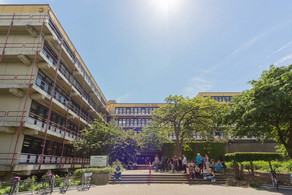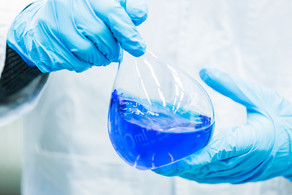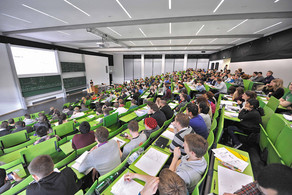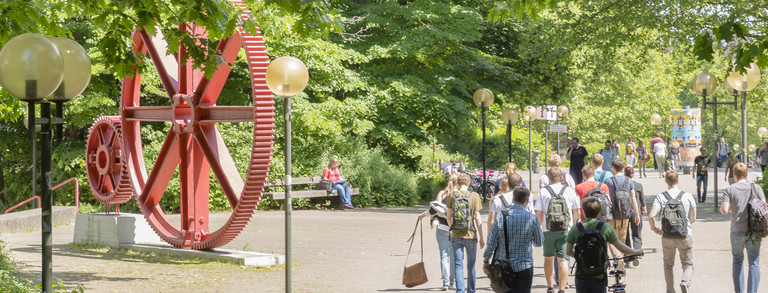Research Activities
1) Polymeric Nanoparticles for Micellar Catalysis and Cascade Reactions in Water
Polymer-supported catalysis has witnessed increasing interest in the past years. The main reasons for this is the possibility to carry out organic reactions in water as solvent, protect water-sensitive catalysts and substrates in an aqueous environment, modulate catalyst activity and selectivity and offer simplified product purification and catalyst recycling. We have developed a platform of amphiphilic block polymers that self-organize in water and form catalytically active micelles.1 These micelles can be used to encapsulate catalysts to perform e.g. Au-based catalysis in a micellar system2 (with Prof. N. Krause, TUD) or to covalently link the ligands / catalysts to the block copolymer and subsequently to the micellar core1,3 or shell.4
An impressive application of such micellar systems is the development of DNA-encoded molecular libraries (with Dr. A. Brunschweiger).4 The micellar aggregates protect the DNA from premature degradation by ensuring spatial separation of catalyst and DNA. Another element of this research addresses the question of how multistep reaction sequences can be realized with the help of polymer nanoparticles. An example of this is the combination of a lipase-catalyzed ester hydrolysis followed by a Cu(I)-catalyzed oxidation reaction.5
References:
1J. Organomet. Chem. 2005, 690, 4648-4655; Angew. Chem. Int. Ed. 2006, 45, 1309-1312; Macromol. Chem. Phys. 2008, 209(11), 1152-1159; 2Adv. Synth. Catal. 2016, 358, 1491 –1499; 3 RSC Adv. 2015, 5, 38235-38242; 4J. Am. Chem. Soc. 2019, 141, 26, 10546-10555; 5 RSC Adv. 2017, 7, 33614-33626.
2) Fabrication of Tailor-Made Hydrogel Matrices for Stem Cell Research
The reconstitution of stem cell niches with functional equivalents of the natural tissue is a challenging task in stem cell therapy. Our current research is focused on the development of synthetic polymers that mimic the microenvironment of stem cell niches. A main focus of our work is concerned with the development of polymer matrices that are suitable for 2D and 3D cell experiments.
In cooperation with Prof. A. Faissner (RUB) we study the effect of polymer composition, the presentation of ECM motifs and the presence of cationic charges on the behavior of neural stem cells.1-3 The aim of our research is to elucidate further mechanism that control stem cell function, such as cell viability and differentiation and at the same time reduce the complexity of the artificial stem cell niche.
References:
1Macromol. Biosci. 2017, 17, 1600178; 2Molecular Neurobiology 2019, 56, 632–647; 3Fronties in Neurosci. 2020, 14, 475.
3) Polymeric Nanoparticles for Diagnostics and Drug Delivery
The development of multifunctional nanoparticles for potential application in drug delivery and diagnostics is a rapid emerging field. The main challenge is how to tailor nanoparticles for specific intracellular applications as contrast agents, drug delivery vehicles, and therapeutics. By developing tailor-made macromonomer surfactants based on poly(2-oxazolines) and their application in a microemulsion process we were able to fabricate a set of core-shell nanoparticles in the size of 20 to 80 nm.1 Furthermore, the versatility of the polymerization process allows the selective incorporation of a diagnostic function such as SiFA moieties (with Prof. K. Jurkschat). Subsequent 18F‑radiolabeling and in vivo PET analysis of these nanoparticles in a murine mammary tumor model (EMT6) (with Prof. R. Schirrmacher, Univ. of Alberta, CA) displayed size selective accumulation in the tumor tissue.2
References:
1 Mcaromol. Chem. Phys. 2016, 217, 1704−1711; RSC Adv. 2016, 6, 9752–9763; 2 Bioconjugate Chem. 2018, 29, 89-95.
4) Biobased Polymeric Thickeners for Lubricant Application
Lubricants are substances that reduce friction between surfaces in mutual contact and therefore find many different applications in automotives but also many other industries. A main component of all lubricants are the thickeners that can be either based on a metal soap or polymers such as polyethylene, PTFE, and oligoureas. Within our FNR-supported research project together with the CARL BECHEM GMBH (industrial partner) and the Institute for Machine Elements and Systems Engineering (MSE), RWTH Aachen University, we investigate the effect of biobased polymeric thickeners on the rheological and tribological behavior of lubricants.





